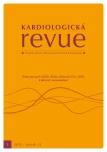Cardiogenic shock
Authors:
J. Pařenica
Published in:
Kardiol Rev Int Med 2011, 13(1): 20-23
Category:
From Hypertension to Heart Failure
Overview
The most common cause of cardiogenic shock is acute myocardial infarction. Severe left ventricular dysfunction, systemic inflammatory response syndrome, mechanical complications, impairment of the right ventricle and iatrogenic injury may contribute to the development of cardiogenic shock. Emergent coronary revascularization should be performed on the infarct-related artery and on other critical narrowings of coronary arteries. The elementary mechanical support for patients in cardiogenic shock is intraaortic balloon counterpulsation. Haemodynamic monitoring is used to ensure the optimal filling of the left ventricle (PCWP 18–22 mmHg). In the event that hypotension is resistant to catecholamines, where hypotension persists despite a combination of mechanical support, norepinephrine, dobutamine and adrenaline, the administration of terlipressin and substitute doses of corticosteroids may be considered as pharmacological rescue therapy. When renal failure occurs, the early initiation of continuous veno-venous hemofiltration is indicated. This can lead to a reduced need for vasosuppressants.
Keywords:
cardiogenic shock – myocardial infarction – IABP – hypotension resistant to catecholamines
Sources
1. Van der Werf F, Bax J, Betriu A et al. ESC Committee for Practice Guidelines (CPG). Management of acute myocardial infarction in patients presenting with persistent ST-segment elevation: the Task Force on the Management of ST-Segment Elevation Acute Myocardial Infarction of the European Society of Cardiology. Eur Heart J 2008; 29: 2909–2945.
2. Hamm CW, Mollmann H, Bassand JP et al. Acute complications of ST-elevation myocardial infarction. In: Camm J, Lüscher TF, Serruys PW (eds). The ESC Textbook of Cardiovascular Medicine. 2 ed. Oxford: Oxford University Press 2009: 587–590.
3. Reynolds HR, Hochman JS. Cardiogenic Shock: Current Concepts and Improving Outcomes. Circulation 2008; 117: 686–697.
4. Špinar J, Janský P, Kettner J et al Doporučení pro diagnostiku a léčbu akutního srdečního selhání. Cor Vasa 2006; 48: K3–K31.
5. Hochman JS, Buller CE, Sleeper LA et al. Cardiogenic shock complicating acute myocardial infarction – etiologies, management and outcome: a report from the SHOCK Trial Registry. SHould we emergently revascularize Occluded Coronaries for cardiogenic shocK? J Am Coll Cardiol 2000; 36: 1063–1070.
6. Widimsky P, Hlinomaz O, Kala P et al. Diagnostika a léčba akutního infarktu myokardu s elevacemi ST. Doporučení České kardiologické společnosti. Cor Vasa 2010; 51: 724–740.
7. Wijns W, Kolh P, Danchin N et al. Guidelines on myocardial revascularization. Eur Heart J 2010; 31: 2051–2555.
8. Berisha S, Kastrati A, Goda A et al. Optimal value of filling pressure in the right side of the heart in acute right ventricular infarction. Br Heart J 1990; 63: 98–102.
9. Overgaard CB, Dzavik V. Inotropes and Vasopressors: Review of Physiology and Clinical Use in Cardiovascular Disease. Circulation 2008; 118: 1047–1056.
10. Ferrario M, Poli A, Previtali M et al. Hemodynamics of volume loading compared with dobutamine in severe right ventricular infarction. Am J Cardiol 1994; 74: 329–333.
11. Thygesen K, Alpert JS, White HD et al. Joint ESC/ACCF/AHA/WHF Task Force for the Redefinition of Myocardial Infarction. Universal definition of myocardial infarction. Eur Heart J 2007; 28: 2525–2538.
12. Cheng JM, den Uil CA, Hoeks SE et al. Percutaneous left ventricular assist devices vs. intra-aortic balloon pump counterpulsation for treatment of cardiogenic shock: a meta-analysis of controlled trials. Eur Heart J 2009; 30: 2102–2108.
13. Rokyta R, Pechman V. The effects of levosimendan on global haemodynamics in patients with cardiogenic shock. Neuro Endocrinol Lett 2006; 27: 121–127.
14. Miklik R, Pařenica J, Felšoci M et al. Levosimendan v léčbě akutního srdečního selhání – zkušenosti z kardiologické kliniky. Cor Vasa 2009; 51: 507–512.
15. Holt NF, Haspel KL. Vasopressin: a review of therapeutic applications. J Cardiothorac Vasc Anesth 2010; 24: 330–347.
16. Jolly S, Newton G, Horlick E et al. Effect of vasopressin on hemodynamics in patients with refractory cardiogenic shock complicating acute myocardial infarction. Am J Cardiol 2005; 96: 1617–1620.
17. Giugliano GR, Giugliano RP, Gibson CM et al. Meta-analysis of corticosteroid treatment in acute myocardial infarction. Am J Cardiol 2003; 91: 1055–1059.
18. Geppert A, Steiner A, Delle-Karth G et al. Usefulness of procalcitonin for diagnosing complicating sepsis in patients with cardiogenic shock. Intensive Care Med 2003; 29: 1384–1389.
19. Kohsaka S, Menon V, Iwata K et al. SHOCK Investigators. Microbiological Profile of Septic Complication in Patients With Cardiogenic Shock Following Acute Myocardial Infarction (from the SHOCK Study). Am J Cardiol 2007; 99: 802–804.
20. Brochard L, Abroug F, Brenner M et al. ATS/ERS/ESICM/SCCM/SRLF Ad Hoc Committee on Acute Renal Failure. An Official ATS/ERS/ESICM/SCCM/SRLF Statement: Prevention and Management of Acute Renal Failure in the ICU Patient: An International Consensus Conference in Intensive Care Medicine. Am J Respir Crit Care Med 2010; 181: 1128–1155.
Labels
Paediatric cardiology Internal medicine Cardiac surgery CardiologyArticle was published in
Cardiology Review

2011 Issue 1
Most read in this issue
- Cardiogenic shock
- Is the prognosis of congestive heart failure patients still so bad?
- Mechanical ventricular support devices in heart failure treatment
- Latent obstruction in outflow tract of left ventricle in patient with hypertrophic cardiomyopathy
